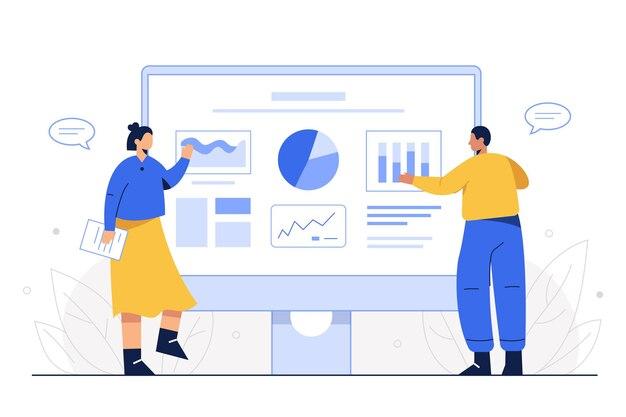Understanding data-driven advertising begins with research. In recent years, customer behavior has changed due to the numerous approaches made available by technology. Advanced technology makes it possible to collect and analyze large amounts of data.
Advertisers employ data-driven marketing strategies to understand which adverts and advert channels will attract customers. It reaches the intended audience of a marketing campaign with customized messages that enhance the customer experience.
These exceed their sales dreams and observe personalization techniques 83% of the time. Furthermore, businesses that employ data-driven personalization have achieved 5-8 times their ROI in their advertising investments.
This guide will help you understand data-driven marketing and the value of using data to make marketing decisions. It will also look at the tools marketers use to make data-driven decisions and the pros and cons of using data to make marketing decisions.

Data-driven marketing is a fixed number of strategies and processes. It uses large quantities of records to create robust marketing processes. It also concentrates on unique demographics and consumer corporations on a personal level.
Data has become increasingly important for entrepreneurs. It can be the most valuable asset in marketing, and extensive records are taken directly from customer interactions. That is the type of data that can assist in refining, decorating, and enhancing any marketing strategy.
The data includes customer information, market trends, and industry insights. Data-driven advertising utilizes advanced data analytics to pinpoint the most influential media buys and create personalized product messages.
New advertising and marketing technology makes it viable to customize each element of advertising. Digital advertising company Stirista outlines the steps to implement a personalized advertising campaign. These steps are:

A survey conducted by Harvard Business Review and supported by SAS, Intel, and Accenture was identified. The survey outlines three interrelated capabilities that enable businesses to utilize analytics and insights to create powerful customer experiences:
Customer Cost Analytics is a system designed to help companies understand customer preferences. The following metrics help determine a customer’s value to a business:
A successful Omni-channel marketing strategy requires four elements, according to MarTech Advisor:
Integrating various data types from internal and external sources will improve customer engagement. Before any data usage, it must be cleaned and conditioned, as MarTech Series explains. This formula enables marketers to evaluate technology across three categories:

Here are five methods entrepreneurs use to gain insights. They extract data from internal and external sources to better understand their target audiences.
Tailored content is a great way to get people’s attention. Online interactions are primarily based on demographics such as buy history, online activity, and other statistics.
For example, DirecTV created a customized marketing campaign. It focused on people who have moved lately.
Implementing an omnichannel strategy requires a unique approach. Acxiom, a web marketing company, defines identity decisions to facilitate data-driven advertising as “the ability to accurately identify an entity (person, place, or thing) and its related relationships in physical and virtual contexts.
This approach cleverly coordinates advertising across channels, considering each customer’s traits, such as interests and generation footprint.
Companies can use predictive analytics to target prospective customers who fit the company’s ideal customer profile (ICP). Digital advertising firm Leadspace explains that ICP lets companies “manage the best leads through the sales funnel.”
An AI-based solution for creating an ICP has three parts:
Combining technology with artistic insight can make big data more understandable. TechGenyz has reviewed the ROI of analytics and intelligence solutions for each dollar spent on them. Organizations see a mean return of $13.01, representing an ROI of 1,301%.
TechGenyz identifies methods you can use to increase the ROI of your advertising campaigns:
Digital Doughnut defines data onboarding as seamlessly transitioning offline data to online systems for marketing purposes.
That includes postal addresses, cell phone numbers, and in-store purchases. Data onboarding includes anonymizing the statistics earlier than they’re shared.
The use of offline statistics helps entrepreneurs get a better understanding of their customers. It’s like having a secret weapon to reach the right clients for their business goals. Plus, it allows them to create personalized messages based on customer data.

Optimizely is a “modern transport and experimentation platform.” It is designed to allow entrepreneurs to base their choices on real-time data and analytics.
One of the most helpful tools that allow teams to gain insight into how customers engage with the company’s websites is Google Analytics. It provides deep and specialized analytics to help you optimize your site.
Another essential tool for data-driven marketing is Google Search Console. It helps web page owners by showing them the specific search queries leading visitors to their site.
Google Page Speed Insights generates an overall performance rating. It indicates how speedy pages run on cellular and laptop devices.
The provider utilizes system learning to provide valuable insights from the business’s data. That includes identifying which customers are most likely to purchase a product and determining which products have the highest sales potential.
Crazy Egg is a “heat-mapping device” that creates two-dimensional data representations. Customers can use data to enhance their search in Google and find results.
Among the analytics equipment, Crazy Egg provides an A/B tester for evaluating unique differences between pages.
BuzzSumo is a fantastic tool that analyzes the most popular online content based on specific keywords, including brands, technologies, and trending topics. If you’re a marketer, Location Rebel has covered you with their informative guide on the five toolkits used.
SEMrush helps entrepreneurs gather valuable information about their competitors by tracking various website traffic sources. That includes direct visits, search engine referrals, paid advertisements, and social media interactions.
A social media toolkit manages the company’s feeds by scheduling and monitoring posts.
HubSpot seamlessly combines content marketing, social media marketing, landing pages, SEO, and web analytics in a user-friendly way.
Content Marketing Toolkit analyzes the posts in a marketing campaign.
Competitive Research Toolkit helps marketers analyze and improve their competitors’ online strategies.
MailChimp offers a user-friendly advertising platform design. That helps entrepreneurs gain valuable insights into their target audiences through backlinks, site visits, and organic research.

Marketers must understand that successful data-driven advertising and marketing requires fine-tuning applicable data. It also involves taking an innovative approach to reach out to customers.
In today’s increasingly consumer-driven world, it is essential to anticipate future trends for a successful marketing campaign. In many ways, data-driven marketing is necessary.
With the ever-changing expectations and innovative desires of customers, it is essential to utilize this approach. However, it is vital to recognize the challenges and intricacies that come with it.
, January 30, 2022, Team LimeCall

Top rated callback automation platform that connects your website visitors to your team within 20 seconds through phone callback and whatsapp driving upto 40% more conversions.
Learn more